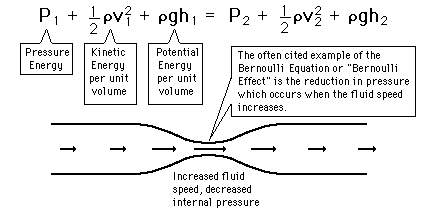Equação de Bernoulli
A equação de Bernoulli pode ser considerada como uma afirmação do princípio da conservação de energia apropriado para fluxo de fluidos.
Energia por unidade de volume antes = Energia por unidade de volume depois

Equação de BernoulliA equação de Bernoulli pode ser considerada como uma afirmação do princípio da conservação de energia apropriado para fluxo de fluidos. Energia por unidade de volume antes = Energia por unidade de volume depois
Cálculos de Bernoulli |
|
Cálculos com BernoulliThe calculation of the "real world" pressure in a constriction of a tube is difficult to do because of viscous losses, turbulence, and the assumptions which must be made about the velocity profile (which affect the calculated kinetic energy). The model calculation here assumes laminar flow (no turbulence), assumes that the distance from the larger diameter to the smaller is short enough that viscous losses can be neglected, and assumes that the velocity profile follows that of theoretical laminar flow. Specifically, this involves assuming that the effective flow velocity is one half of the maximum velocity, and that the average kinetic energy density is given by one third of the maximum kinetic energy density. |
||||
|
Inlet tube energy densities |
Constricted tube energy densities |
|||
|
Kinetic energy density |
= erg/cm^3 |
Kinetic energy density |
= erg/cm^3 |
|
|
Potential energy density |
= erg/cm^3 |
Potential energy density |
= erg/cm^3 |
|
|
Pressure energy density |
= erg/cm^3 |
Pressure energy density |
= erg/cm^3 |
|
|
HyperPhysics***** Mechanics ***** Fluids |
||||
Curve of a Baseball
|
|
|
HyperPhysics***** Mechanics ***** Fluids |
Airfoil |
||
|
|
The air across the top of a conventional airfoil must travel further than the air across the bottom. This causes a decrease in pressure on the top according to the Bernoulli equation and provides a lift force. Increasing the angle of attack gives a larger lift from the upward component of pressure on the bottom of the wing. This is the primary source of lift in most aircraft. At too high an angle of attack, the drag produced by turbulent flow will reduce the lift to the point of stalling the aircraft. |
|
|
HyperPhysics***** Mechanics ***** Fluids |
||